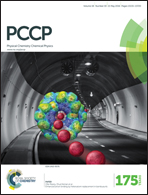Electron interaction with a DNA duplex: dCpdC:dGpdG†
Abstract
Electron attachment to double-stranded cytosine-rich DNA, dCpdC:dGpdG, has been studied by density functional theory. This system represents a minimal descriptive unit of a cytosine-rich double-stranded DNA helix. A significant electron affinity for the formation of a cytosine-centered radical anion is revealed to be about 2.2 eV. The excess electron may reside on the nucleobase at the 5′ position (dC˙−pdC:dGpdG) or at the 3′ position (dCpdC˙−:dGpdG). The inter-strand proton transfer between the radical anion centered cytosine (N3) and the paired guanine (HN1) results in the formation of radical anion center separated complexes dC1H˙pdC:dG2-H−pdG and dCpdC2H˙:dGpdG1-H−. These distonic radical anions are found to be approximately 1 to 4 kcal mol−1 more stable than the normal radical anions. Intra-strand cytosine π → π transition energies are below the electron detachment energy. Inter-strand π → π transitions of the excess electron from C to G are predicted to be less than 2.79 eV. Electron transfer might also be possible through the inter-strand base-jumping mode. An analysis of absorption visible spectra reveals the absorption bands ranging from 500 nm to 700 nm for the cytosine-rich radical anions of the DNA duplex. Electron attachment to cytidine oligomers might add color to the DNA duplex.


 Please wait while we load your content...
Please wait while we load your content...